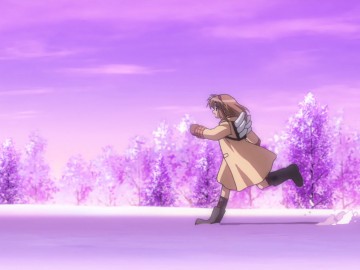This is a follow-up to the previous “Best Anime Series” posting. I’m not implying with the title that these are somehow worse, or better, than the previous 5+, I’m just listing the anime series which have made a lasting impression since I wrote the original posting about a year ago.
1. Gosick (ゴシック,Goshikku)
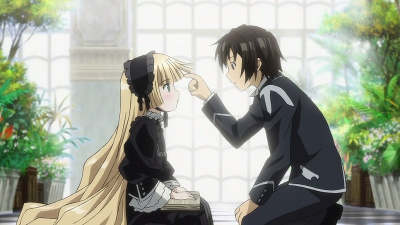
‘Gosick‘ is an adaptation of light novel series by Kazuki Sakuraba, the 24-episode TV anime version was being produced by Bones in 2011.
The story of ‘Gosick‘ is set into an alternate history in the year 1924, the main deviations being the fictional country of Saubure (or Sauville in some translations), sandwiched between France and Italy, and the Second World War occurring in the late 20’s. The story starts when a transfer student from Japan, Kazuya Kujo, arrives at the St. Marguerite Academy of Saubure, and meets in the library a girl, Victorique de Blois. Victorique is a small, doll-like girl with a very long flowing blonde hair; she has a very sharp tongue and a blunt, eccentric attitude, but at the same time she cares deeply for Kazuya (i.e. a perfect example of a tsundere). She is very fond of sweets and frilly dresses, and is also extremely intelligent, to the point of working as a consulting detective to her step-brother, Police Inspector Grevil de Blois.
Aoi Yūki as Victorique’s seiyū, or voice actor, does an incredible job in portraying her abrupt nature. Now that I know the episodes by heart, on re-watchings it has become very enjoyable to follow the little but important nuances she puts on her extremely professional voice acting. One memorable example: listen to the little huffs and puffs Victorique makes when he tries to open a parasol in episode 12…
The first few episodes deal a series of seemingly disconnected crime cases, which are solved by Victorique. The main storyline begins at the middle of the series, continuing to the end. So, why do I like Gosick so much? The prophecy which the Gray Wolves’ village elder told to Kazuya summarizes it neatly: “Years from now, a gale strong enough to shake the world will blow. Your bodies are light; that gale will surely separate the two of you. However, your hearts will never be apart.”
Call me a hopeless romantic, but this kind of story, and especially the ending of this particular series, gets me every time…
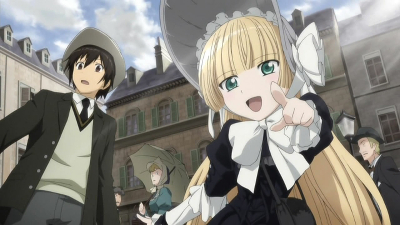
The opening theme is made in a very beautiful Art Nouveau style; the same style is used in several places in the series, for example in the ‘Coco Rose’ poster. I’m very interested in and attracted to the Art Nouveau (~1895-1914) and Art Deco (~1920-1939) art movements, so naturally this caught my eye immediately.
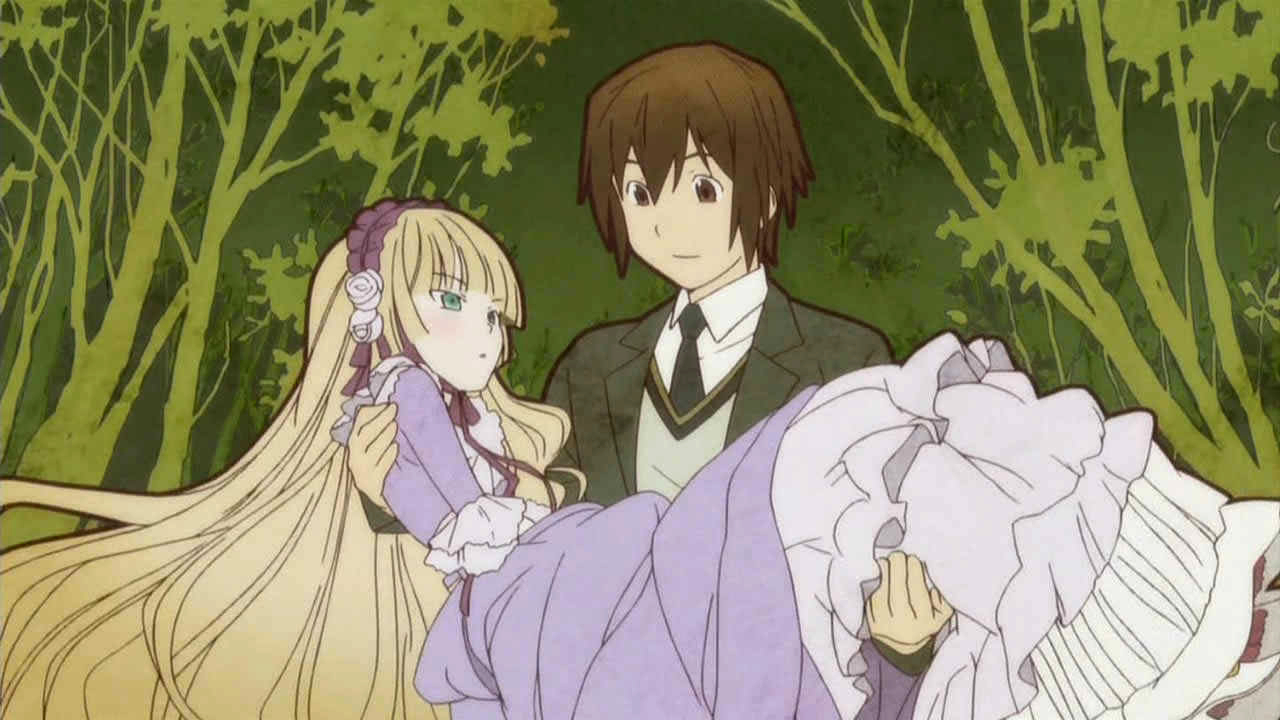
(OT: I wish someone would do the whole anime using that kind of drawing style; Hyakka Ryōran Samurai Girls and Chōyaku Hyakunin isshu: Uta Koi are quite close, but not enough…)
Concerning the ‘alternate history’ setting, there was one thing which caught my eye. I don’t know whether it is a hilarious slip-up or an intentional poke to the car enthusiasts: In the last episode there’s a car parked in front of the police station – I think it’s meant to be Jacqueline’s car – and the scene is set to happen in 1929. But the car in question is a 1961-or-newer Citroën 2CV… I’m first to admit that the 2CV looked quite old-fashioned even when new, but here it still feels misplaced…
2. Hyouka (氷菓,Hyōka)
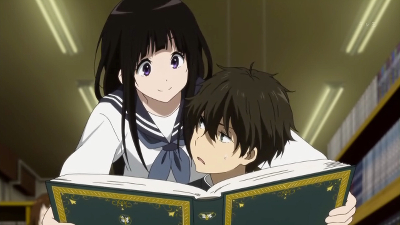
‘Hyouka‘ is based on a mystery novel by Honobu Yonezawa. A 22-episode anime adaptation was produced by Kyoto Animation and directed by Yasuhiro Takemoto in 2012.
Hōtarō Oreki is a rational boy who doesn’t like to do things that he considers a waste of energy. However, at the request of his older sister Tomoe he joins Kamiyama High School’s Classic Literature Club to stop it from being abolished. At the same time a beautiful girl Eru Chitanda (whose curiosity is easily aroused, but not as easily satisfied) joins the Club, too. Later, his friends Satoshi Fukube (who calls himself a ‘database’) and Mayaka Ibara (who is in love with Fuku-chan, but doesn’t get along with Hōtarō) join in. Together they began to discuss and investigate a variety of mysteries in school that only Hōtarō seems to be able to solve; including the mystery that lingered on from Eru’s childhood memory.
Quite a lot of people I know have described Hyouka as ‘dull’ and ‘too slow’. I think they all miss the point here. First, although Hyouka is often described as ‘detective story’, it actually isn’t, that’s just a side-story. Second, it is a japanese series, and the eastern people tend to like more the slower paced shows than us westerners, especially if it is a romantic / love story. And that is what Hyouka really is: a story of slowly developing respect, affection and love between Hōtarō and Eru…
Personally, I enjoy Hyouka greatly because of the slow pace. Graphically, the attention to detail is incredible in some scenes. Also, I find it easy to identify with Hōtarō, we are quite similar in character.
“私、気になります Watashi, kininarimasu!” (Eru’s catchphrase: “I’m curious!”)
I hope that in retrospect the people will see Hyouka as it is: the finest show Kyoto Animation has ever produced!
3. Poyopoyo (ポヨポヨ観察日記,Poyopoyo Kansatsu Nikki)
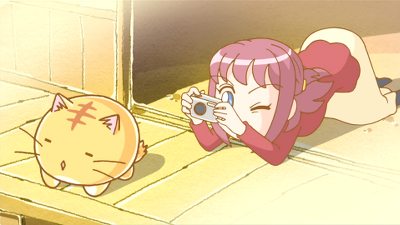
‘Poyopoyo‘ is a Japanese manga series created by Rū Tatsuki, and adapted into a 52-episode (~2:50 min each) anime TV series in 2012.
The series revolves (almost literally) around a spherical orange cat named Poyo and the Satou family (Moe, Hide and Shigeru) that has adopted him. It is a heartwarming and delightful slice-of-life series, and very well made considering the episodes are only less than 3 minutes in length.
The ‘sounds’ (I just can’t call them ‘meows’…) made by Poyo are absolutely hilarious, especially in episode 11 where he has been left outside and wants to get in…
4. Kids on the Slope (坂道のアポロン,Sakamichi no Apollon)
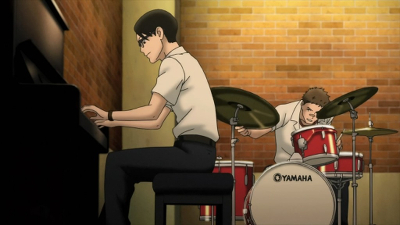
‘Sakamichi no Apollon‘ is originally a manga series by Yuki Kodama. A 12-episode anime adaptation was made in 2012, which was directed by Shinichirō Watanabe of MAPPA/Tezuka Productions, and the series’ music was provided by the acclaimed composer Yoko Kanno.
The story is set to summer 1966, when a freshman high school student Kaoru Nishimi has moved to live with relatives in Kyūshū. He’s been a honor student who tended to keep to himself his whole life, but that starts to change when he meets Sentarō Kawabuchi, the school’s notorious bad boy. Through him, he learns the appeal of jazz and forms his first real friendships. He also meets Sentarō’s childhood friend Ritsuko Mukae, whose father owns the local record shop. Other acquaintances include Junichi “Brother Jun” Katsuragi, and Yurika Fukahori.
The series is all about finding friendship, love and music. For me, it was that last part which attracted me to the series. Also, the whole 60’s atmosphere and lifestyle in contemporary Japan is well conveyed.
5. Girls und Panzer (ガールズ&パンツァー,Gāruzu ando Pantsā)
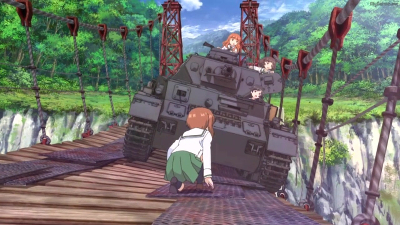
‘Girls und Panzer‘, or ‘Garupan‘ for short, is an anime TV series created by Actas. There were 12 episodes (and 2 – totally unnecessary, if you ask me – recap episodes) shown between late 2012 – early 2013.
The story takes place in a universe where girls participate in Sensha-dō (戦車道), the art of operating tanks, as a traditional martial art. Miho Nishizumi, a girl who has had a bad experience with Sensha-dō, transfers to Ōarai Girl’s High School to get away from it. However, soon after joining, the school revives Sensha-dō and Miho, being the only student with any experience in operating a tank, is ordered to take part. Despite being initially reluctant, Miho soon comes to enjoy Sensha-dō again and, joined by her new friends; Saori, Hana, Yukari and Mako, enters a national Sensha-dō championship where they face off against various other schools.
The basic idea behind this series – young schoolgirls running around in WWII-era tanks – is so ridiculously silly that I almost stopped watching it after the first episode. Fortunately, I gave it a second chance, and to my eternal delight found out that the series is actually very entertaining. The graphics is good, especially the CGI used in tanks. Nicely enough all of my favourite tanks are there: StuG III, Churchill, KV-1…
“Panzer vor!”
5+. Humanity Has Declined (人類は衰退しました,Jinrui wa Suitai Shimashita)
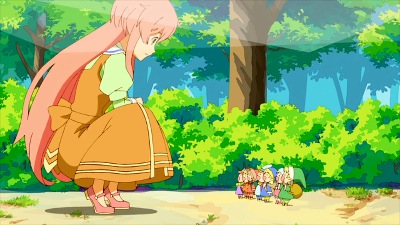
As happened last time, I couldn’t decide which one to leave out, so here’s the runner-up:
‘Jinrui wa Suitai Shimashita‘, or ‘Jintai‘ for short, is a light novel series written by Romeo Tanaka. The 12-episode anime adaptation was aired in 2012, and was made by AIC A.S.T.A. studio.
The story is set in a post-apocalyptic world where the human civilization has regressed and mankind keeps decreasing in numbers. The story follows an unnamed girl (voiced by Mai Nakahara, also known as ‘Nagisa Furukawa’ in Clannad) who acts as an UN mediator between humanity and the “fairies” who are small dwarf-like creatures attracted by sweets and happy things, but also have the habit to cause trouble to her with their powers in their endless search for amusement.
This is a very entertaining and totally twisted story of the last days of human race. The main character is at the same time intelligent and cynical, the fairies are at the same time adorable and disturbing, also the episodes aren’t shown in a linear order, or maybe those are just time paradoxes created by the fairies… The graphics design of the series is very weird; the color palette uses lots of pastel colors… well, it is difficult to explain in words, just watch the series!
However, in the end I’d like to know which kind of mushrooms the design team was eating at the time…

